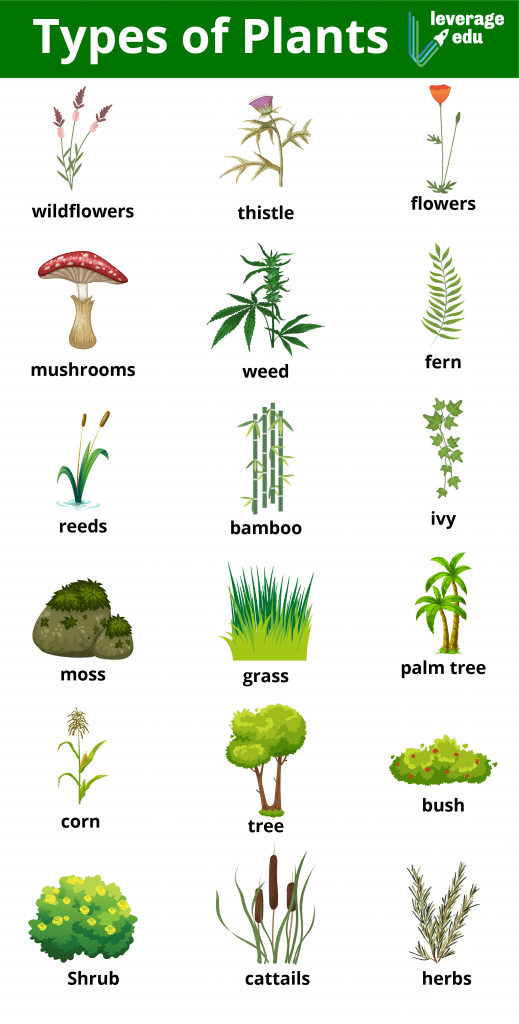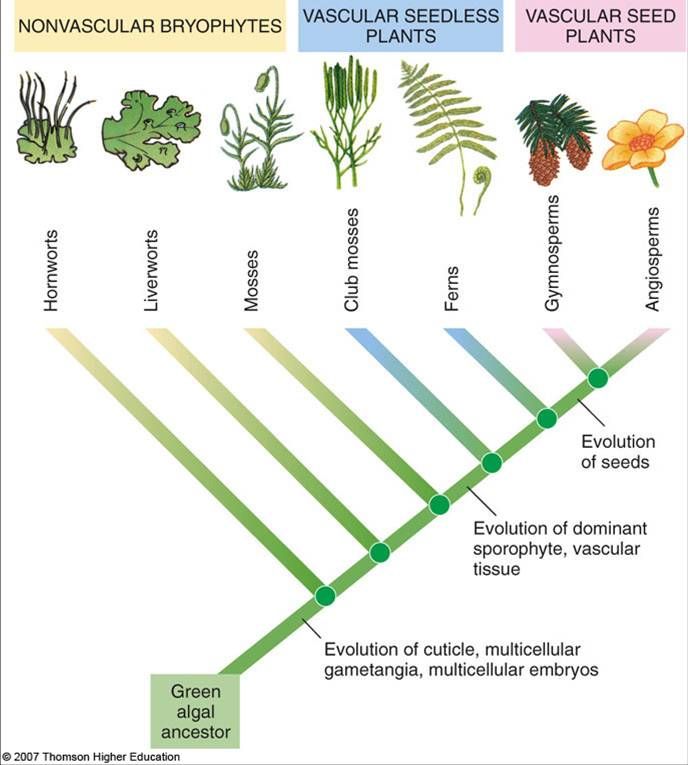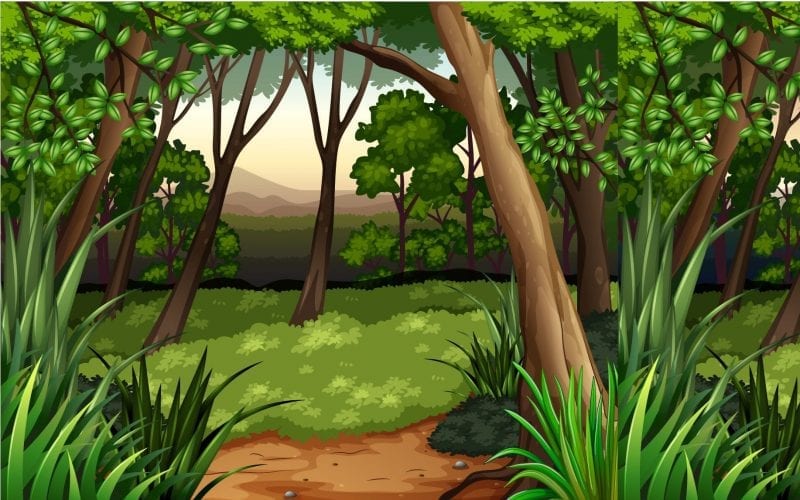Plants are considered the most generous living beings and there is no denying the fact that life on Earth would be possible without plants and trees around us. It’s because they produce oxygen as well as grow food for human beings and animals. However, the importance of plants does not just end here. They are also responsible for absorbing the carbon dioxide present in the air and releasing fresh air for us to breathe. They support the nitrogen cycle and play an imperative role in the water cycle. They are the main source of food and their existence has an essential part in sustaining the survival of other living beings. In class 8 science, students are taught about how a seed develops into a plant. Through this blog, we will take you through the different types of plants based on the classification of age, seeds as well as size.
Also read: Science Projects for Class 8 & Working Models
This Blog Includes:
What are Plants?
In simple language, plants are living things. The habitat on land and on water. The important thing about plants is that they can thrive anywhere, from snow-clad mountains to the dry dust of the desert, Plants can be found everywhere. Plants can be divided into groups: Flowering Plants and Non-Flowering Plants.
- Flowering Plants: Plants which bare flowers are called flowering plants. Examples are: Orchids, Roses, Sunflowers, etc.
- Non-Flowering Plants: Plants which do not bare flowers are known as non-flowering plants. Examples are: Ferns, Mosses, etc.
Plants have the capability of making their own food. They can do so with the help of sunlight and water. Plants cannot move from one place to another like human beings and animals, most plants are rooted to the ground. Plants produce oxygen which is the most important need of lying organisms to survive. There are more than 3 lakh species of plants on Earth!
Did you know: 3.34 m is the recorded height of the tallest basil plant.
Class 8 Crop Production and Management
Parts of Plants
There are five main parts of plants, i.e. Roots, Stem, Leaves, Fruits and Flowers. Let’s get to know about each part of a plant and the role it plays.

Roots
Roots are the part of plants that are found underground. It is the most important part of the plant. Roots hold the plant firm and strong in the soil. The main function of the roots is to absorb minerals and water from the soil. They even store the reserve food material for later use by the plants.
Primary roots are formed by the direct elongation of the radicle. They grow in the dicots. Secondary roots are known as Tertiary roots. Those types of plants which are monocots have a large number of roots in place of the primary root because it has a short life span.
Stem
The part of the plant which is found above the ground is known as the Stem. It is the main organ of the shoot system and bears fruits, leaves and flowers. Leaves arise from the region of the stem known as Node. The areas in and around the nodes are known as Internodes. There are many important functions of the stem. These are:
- Reproduction
- Support
- Storage
- Guards
- Transportation
Did you know: Ginkgo Biloba is one of the oldest tree species that is alive.
Leaves
Another most important part of the plant is the leaves. Leaves carry within them chlorophyll which is used by plants to prepare their food with the help of sunlight, water and carbon dioxide. There are three primary parts of a leaf: lamina, leaf base and petiole.
- The main function of the petiole if to keep the leaf exposed and keep it cool when it comes in contact with the wind.
- The protruding part of the leaf is known as leaf base.
- Veins and veinlets are contained in the lamina of the leaf. They help in giving the required rigidity to the leaf and also in transporting the minerals.
The main functions of the leaf include:
- Reproduction: The leaves of certain plants also help in the process of reproduction. For example, the Bryophyllum plant.
- Photosynthesis: The process of producing food by green leaves by using carbon dioxide and water in the presence of sunlight is known as photosynthesis.
- Transpiration: The removal of excess water from the stomata of the plant is known as transpiration. Leaves play a crucial role in the transpiration of plants.
Fruits
The matured ovary of the plant which develops after the process of fertilisation is known as fruit. It is the most important feature of a plant which is flowering.
Flowers
The reproductive part of the plant is known as a flower. It is the most attractive part of the plant. A flower comprises four main parts. They are:
- Pistil
- Stamen
- Petals
- Sepals
Did you know: The leaves of the Lucky Bamboo plant grow up to one inch per month.
Know about the List of NCERT Books Class 8: All Subjects
What is Growth Habit?

Growth Habit or plant habit refers to a plant’s life, characteristics, and diverse properties. It signifies the shape, appearance, or growth form of a plant species. It develops from specific genetic patterns of growth in combination with environmental factors and is part of the organization of every plant.
Did you know: 80 percent of the Earth’s original forests have been cleared or destroyed
Types of Plants

Types of Plants Based on Size
One of the important categories of classification, plants can also be differentiated in terms of their size. From small, medium to huge, the growth of a plant remains limited to the size it corresponds. Take a look at their different types as per the category of size.
Herbs
Herbs are considered the smallest in size. Their heights are not more than a foot or a few centimetres and consist of soft stems. Generally, they have fewer branches or none. These herbs are filled with vitamins and minerals and are an essential part of a nutritious diet. Some of the major examples of herbs are tomato, ginger, paddy, etc.
Shrubs
‘They are also not very big in size but they are bigger than the herbs, almost a meter and have hard stems. Examples of shrubs are Rosemary, Cherry, Basil, etc.
Trees
As we all know, trees are the biggest of plants and have very hard stems which are known as the trunk. The trunk of a tree has branches that bear fruits, leaves and fruits. They can have great heights, mostly more than a meter. Examples of trees are Mango, Banana, etc.
Creepers
Those plants that creep on the ground have very fragile as well as thin and long stems are referred to as creepers. These creepers cannot stand straight or support their own weight. Some of the major creepers include strawberries, sweet potatoes, watermelon, amongst others.
Climbers
Similar to creepers in their thin, long and weak stems, the Climbers cannot stand erect as well but grow vertically through external supports and can carry their own weight. Some of the examples of climbers are money plants, runner beans, grapevine, etc.
Did you know: The very expensive spice, saffron, comes from a type of crocus flower
Related Read: How to become a Botanist?
Types of Plants Based on Life Cycle
Known as the longest living beings on the earth, the classification of age also corresponds to the growth and size of a plant. Every plant completes its life cycle depending upon its surroundings as well as seed and whether it got the required nutrition to grow or not. They are mainly of three types based on the category of the life cycle:
Ephemeral
Ephemerals comprise a very short life span. Having a shorter life cycle that only spans across a few weeks, they grow, reproduce and die and are found almost everywhere. They are not just limited to just a single type of environment and some of the ephemeral plants are Bloodroot, Red trillium, Great White trillium, etc.
Annual
As the name suggests, the annual category corresponds to those plants that only sustain for more or less than a year. Mainly used for growing crops and in agriculture, the popular examples of this type are Watermelon, Maize, Durum, etc.
Biennial
Biennials require two years to complete their biological cycle of growth, reproduction and then decay. During these two years, the first year encompasses their flowering process and they start to die in the subsequent one. Late spring is the flowering time for Biennials and their prominent examples are Kalette, Hollyhock, Potato, Carrot, etc.
Perennial
Having the longest life span of all, Perennials continue to grow for several years. They do not have any fixed age to complete their biological cycle. If they are not harmed by nature or cut down forcefully, they will continue to grow for hundreds of years. Examples of such plants are Strawberry, Basil, Oregano, etc.
Did you know: 85% of plant life is found in the ocean!
Clean and Green Career in Social Forestry
Types of Plants Based on Seeds
Seeds lie the foundation of a plant as their growth mainly relies on the type of seed. Some seeds can be used as food for other living beings while others’ main task is to grow into a new plant. Based on the seeds of a plant, we can divide them into two types.
Monocotyledon
Having have their seeds in one piece, Monocotyledon has a single cotyledon as per their name. Examples of these types of plants are Rice, Orchids, Bamboo and so on.
Dicotyledon
These types of plants have two cotyledons within their seeds which can be divided into two equal parts. Examples of Dictyledon are Cashew, Oaks, etc.

Classification of Plants
Plants can be classified into vascular and non-vascular plants.

Vascular Plants
- Vascular plants are those plants that are green in colour and have tissues which are specialised for the purpose of transporting food, water and minerals to all parts of the plant. These special tissues are known as Xylem and Phloem. These plants can grow longer in length. Examples are Gymnosperms, Pines, Ferns, Angiosperms, Sunflowers and Clubmosses, etc.
- Vascular plants grow on deserts, land and other places.
- The main dominating phase is the sporophyte. The second is the gametophyte.
- The leaves of vascular plants have well defined shapes and play an important role in the process of photosynthesis. The stomata helps in exchange of gases.
- The stem of vascular plants is multi layered and plays an important role in the transportation of food, water.
Non-Vascular Plants
- Non-vascular plants are those plants which do not have a long height. They are short in height and do not have the required transport system for transporting food, water and minerals to other parts of the plant. Such type of plants do not produce fruits, wood or flowers. Examples are Hornworts, Liverworts and Mosses.
- Non-vascular plants grow on swampy, shady and moist places. Xylem and Phloem are absent in Non-Vascular plants.
- The dominating phase in non-vascular plants is gametophyte. The second is sporophyte.
- Leaves are absent in non-vascular plants. Therefore, they do not have a special function.
- Non-vascular plants do niot have a true stem.
Did you know: Brazil is the only country in the world that is named after a tree!
Top Forestry Courses You Must Consider Pursuing
Types of Plants PPT
FAQs
The appearance, shape, height, and form of growth of a plant species are all examples of growth habits. The genetic patterns that determine growth determine a plant’s growth behaviour. When it comes to plants, some are too short to climb, while others are too tall to climb. Aside from height, stem thickness and delicacy vary.
The 5 main types of plants are:
Herbs
Shrubs
Trees
Climbers
Creepers
Scientists have finally found a solution. According to research from the Royal Botanic Gardens, Kew in the United Kingdom, there are around 391,000 species of vascular plants currently known to science, with 369,000 species (or 94 %) being blooming plants.
Herbs have the following characteristics:
They are little plants with soft and fragile stems.
They feature a green stem that is fragile, gentle, and delicate.
They have a brief lifespan, only living for one or two seasons at most.
They are smaller and can grow to be between 2 and 3 metres tall.
Rose, marigold, china rose, and lemon is some of the most common examples of shrubs.
Creepers are plants with weak stems that stretch horizontally along with the dirt on the ground because they are unable to stand upright.
Did you know: The first medicine for fever and body ache was the bark of a willow tree!
Hopefully, this article helped you understand the different types of plants. Planning to study for a degree in Botany? Sign up for an e-meeting with our experts at Leverage Edu and we will guide you in choosing a suitable course and program that aligns with your interests, preferences and aspirations and equips you with the necessary knowledge and skills to build a thriving career in this field. Call us immediately at 1800 57 2000 for a free 30-minute counselling session.
-
Very good knowledge given to you in this site.
-
Very important

 One app for all your study abroad needs
One app for all your study abroad needs





















 45,000+ students realised their study abroad dream with us. Take the first step today.
45,000+ students realised their study abroad dream with us. Take the first step today.


6 comments
Very good knowledge given to you in this site.
Very important
Thank for leverage edu
thanks for your valuable feedback
Iam happy for these studies because it helps me to organize my students in studying this topic thanks alot.
thanks for your valuable feedback